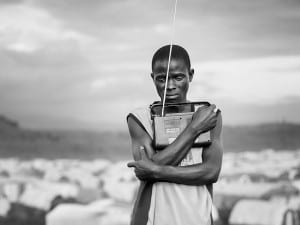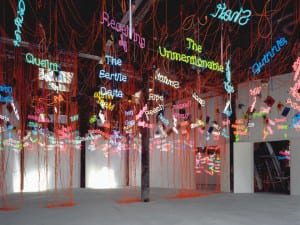Text by Matt Swain
This display, which is a forerunner for the V&A’s forthcoming exhibition Postmodernism: Style and Subversion 1970-1990, explores photographs that make reference to themselves as well as other media, demonstrating the longevity and pervading influence of Postmodernist photography over a 30 year period starting in the 1970s. You can read a preview of the upcoming show in the current issue of Aesthetica which is available here.
The images, which can initially seem superficial, link eras and media ensuring that there is a translation beyond surface depth. They all carry a strong sense of individual style with the duality of connection, this being the crucial link to their place in time as well as the here and now. Scenarios are built or staged and then quite wilfully destroyed, existing only for the purposes of that photograph. The works here, almost 40 photographs, are loosely arranged by theme and are by some of the most influential Postmodernist artists, demonstrating a wide variety of styles and techniques.
David Hockney’s Photography is Dead, Long Live Painting (1995) successfully sets the tone, showing a Get Well Soon card containing a photograph of sunflowers next to Hockney’s painting of them, effectively posing the question as to whether a painting of something can ever be more beautiful than a photograph. Richard Prince, who has been taking sections of advertising images from posters and magazines since the 1970s and making “re-photographs”, is represented here with the Marlboro man in Untitled (Cowboys) (1986), questioning consumerism and the environment in which such advertisements are seen.
Cindy Sherman’s renowned conceptual self-portraiture is exemplified in Untitled (1979) featuring Sherman as a Marilyn-style Hollywood star, captured on camera by the paparazzi. It is a defining moment in what it seeks to be, representing femininity in popular culture and displaying a typically classic sense of modernity. One Flesh (1985) by Helen Chadwick also addresses femininity albeit it from a different perspective, showing mother and baby with a golden placenta floating above, a Renaissance-style collage on cheaply produced photocopies in red, gold and blue, confronting conventional ideas about the human body, the sacred and the feminine.
Throughout, styles clash and mingle. The component parts are familiar but we see them reassembled in new ways, giving them new meaning or multiple meanings and forcing reappraisal, igniting our imagination and suspicion. Peter Kennard’s Haywain with Cruise Missiles (1980) invades Constable’s idyllic vision with a missile launcher on top of the horse-drawn cart. Tess Hurrell’s Chaology no 1 (2006) effectively shows a flimsy, handmade model from cotton wool and talcum powder imitating a nuclear explosion. Ann Hardy took months to create her post-party scene for Untitled IV (2005), and then subsequently destroyed it. The interpretation of the creation remains on the surface, discarded urban objects contrasting with balloons, an unsettling, unfinished and recently vacated chaos.
Arguably the most effective work here is Claire Strand’s Signs of a Struggle (2003), from which the display takes its title. This series of images fascinatingly builds scenes in living rooms, streets and gardens, an allegory of potentially paranormal activity and faked police crime scenes, staged yet utterly convincing. It is this authenticity that makes this real but fun. You are the outsider looking in with the clear knowledge that it is staged.
The later images possess a certain subtlety and humour not always apparent in some of the earlier works but it all somehow feels contemporary, raising questions about how photography is represented and about the meanings within the various layers. Almost without noticing, we are all becoming more accustomed to the idea of looking at two or more irreconcilable ideas as one and making sense of them. Despite some recent debate to the contrary, Postmodernism is alive and well. Who knew that obvious artifice, beautiful fakery and pastiche could be so enticing?
Signs of a Struggle: Photography in the Wake of Postmodernism continues at the Victoria and Albert Museum, London until 27 November 2011
Aesthetica Magazine
We hope you enjoy reading the Aesthetica Blog, if you want to explore more of the best in contemporary arts and culture you should read us in print too. You can buy it today by calling +44(0)1904 479 168. Even better, subscribe to Aesthetica and save 20%. Go on, enjoy!
Images:
Untitled IV (balloons) Ann Hardy (2005) Courtesy Anne Hardy, courtesy Maureen Paley, London and ArtSway





